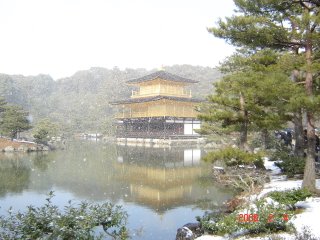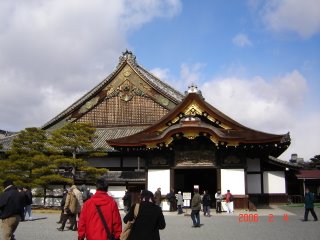Kyoto and Japanese tradition
Kyoto and Japanese tradition
It was in the end of November when Linda told me that her boyfriend and she had a plan to visit Japan for the Chinese New Year. In the beginning she chose Tokyo as their destination and asked me for some advice where to visit. My advice was not to visit Tokyo but to fly to Osaka to visit two past capital of Japan: Kyoto and Nara. There are a lot of temples and shrines in these towns and most foreigners love them. In the end they decided to visit Kyoto instead of Tokyo. So, it has become my obligation to guide them in Kyoto. Well, obligation may not be precise because I always wanted to guide some foreign friends in Japan. Usually, I am the one who travel to visit them. When they see me off in the end of my visit, they say, “You have to show me around Japan when I visit you”. I say ok but they often add “But you are always traveling. You’re never in Japan.” Or they greet me saying “Hi Yasu, it’s been a long time. You’re always traveling” Either way. So, this is my first time to be a guide for foreign friends.
Kyoto
Kyoto is regarded as the center of Japanese culture and history. It had been a capital for almost a thousand years in Japanese history since 794. Even after Shogun, the head of Samurai moved their government; the imperial government remained in Kyoto until 1867. During these eras, Kyoto culture flourished and influenced greatly in our life.
Kyoto is the city that I proudly recommend to foreign tourists.
I took the first flight to Osaka on Friday, the 3rd of February to meet Linda and her boyfriend at the lobby of Kyoto Miyako Hotel. After ten or fifteen minutes of my arrival, they came back to the hotel from a short walk. Linda introduced me to her boyfriend. It was more than three years since we last met.
When I asked her where she wanted to go first. She seemed to have studied her guidebook and said that she wanted to walk along the path called “Tetugakunomichi”, namely Philosopher’s path that leads us to Ginkaku-ji temple, a temple which is crowned the world heritage site.
I had no idea about this path why it is called in such a name.
“I know there are hundreds of Buddhist and Shinto monks in our history but a great philosopher?? We are not Greeks. Well, Japanese exaggerate such a story to bring more tourists. That ‘s what it is! That philosopher could be anyone. ” I made my own conclusion.
“I don’t know the story but we can check it out. It is on the way to Ginkaku-ji temple. That is the one you should not miss while you are in Kyoto” I said to her without revealing much of my ignorance.
Ginkaku-ji temple was built by Ashikaga Yoshimasa, 8th Shogun of Muromachi Bakufu government in the 15th century. The English name is Silver pavilion. It was meant be built to be painted with silver like Kinkaku-ji. However, in the end of Ashikaga Shogun era, the Samurai government was never able to finance this work and has finished without painting it. You may be disappointed with the size of the pavilion. But the garden and the view from the hillside are breathtaking.

Kinkaku-ji temple was built by the third Shogun, Ashikaga Yoshimitsu in 1397, during the most flourished time of the period. The pavilion itself is rather small, too.


The other temple we visited is Kiyomizu Temple. You may be disappointed by visiting previous two temples if you expect to see some truly beautiful Japanese temple. If you feel so, I recommend you to visit Kiyomizu-dera temple. It is built on tall wooden base. In Japanese, there is an expression related to this temple. When we encourage someone to overcome fear or make his mind to set off for a big challenge, we say “Try it bravely like jumping off from the Kiyomizu terrace.” However, I believe that the expression is not really appropriate. Because if you jump off from there, you will definitely break every bone in the body and result in a terrible death!

By the way, there is a small shrine in the place of Kiyomizu Temple that is believed to achieve love. I took a photo of a new Taiwanese couple.

It was snowing in Kyoto. Linda told her boyfriend about her first day of snow in Newcastle, the story how we built a snowman at North terrace. We were four of us. Linda, Michael, Nuno and me. Michael retreated inside in the early stage. You know, people remember events in their past differently. I did not remember that I was the one who taught how to make a snowman till she told me the story again today.
In the second day, we went to Nijo Castle. Unlike other castles or forts, buildings in the castle are no more than two stories. It was because the castle was built for a residence for Tokugawa Shogun, the head of Samurai government to stay during his visit in Kyoto but not to protect themselves from battles. Actually the work was started in 1603 after Tokugawa government won a major war. Therefore, it was built like a palace rather than a castle.

The places where we visited in two days are the major tourist sites in Kyoto. However, Kyoto has a number of other places where you can experience Japanese culture. Tokugawa Shogun took major authority and power from the Imperial government and built a new capital in Tokyo in 1603. Since then, Tokyo has developed as political and economic center. However, Kyoto remained its position as a cultural center. It developed own culture. Nowadays tourists visit Kyoto to enjoy traditional theater, Kabuki, music, tea ceremony and food. Here we concentrate on dining out in Kyoto and its dishes.
Many Europeans whom I met considered the Japanese cuisine is among the healthiest food in the world. It is quite popular in Europe. For example, our beloved football King, Luis Figo is a great fan of Japanese food. Most popular dishes are Sushi, Sahimi (raw fish), Tenpura.
On the second day, we went to the river-side area to have some lunch. We walked along a traditional street and went inside a restaurant where they cook Unagi (grilled eel).
We, Japanese traditionally eat eels grilled with a sweet soy sauce. It is said to be good to regain some strength and energy in your body. An eel is a fresh water fish found in river. It is long and has a smooth skin like a snake. It used to be found in many clean rivers when I was a child. But nowadays, most of eels at supermarket are grown in fish farms same as many other fish. They are given chemicals and mostly tasteless compared to the ones caught in river. So, if you want to eat a good eel, you should go to an eel restaurant.
Here is some grilled eel with a bowl of rice (I do not know the name nor gender of the eel on my plate. It could be Taro or Hanako).

After lunch, we went shopping on the streets of Kyoto and lost our way back to the main street. On that evening, I took a flight back to Fukuoka, wishing for next interesting trip. I hope you gain some knowledge of Japan and became interested in visiting Kyoto.


0 Comments:
Post a Comment
<< Home